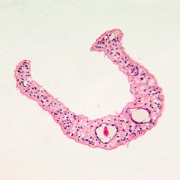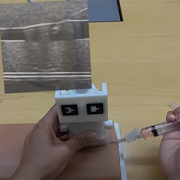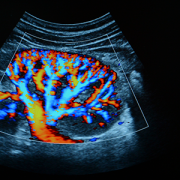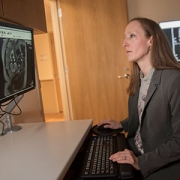Research finalist: targeted ultrasound of the tibial nerve can affect bladder function
Daniel Casella, M.D,, wants to design a bracelet that uses ultrasound waves to stimulate the posterior tibial nerve in pediatric patients with overactive and underactive bladders. “Realistically and optimistically, we might be five years away from that,” says Dr. Casella, a pediatric urologist at Children’s National Health System who has been studying the ability of ultrasound mediated neuromodulation of the posterior tibial nerve to affect bladder function. For this work, he was named a research finalist at the Pediatric Urology Fall Congress in September.
Up to 40 percent of patients seen in a pediatric urology clinic have an element of voiding dysfunction. The majority of these patients can be managed with behavior modification and conservative measures; however there is a subset of these patients who will require more aggressive therapy. With the possibilities that this research holds, he suggests ultrasound mediated tibial nerve stimulation as potentially an ideal outpatient treatment of overactive bladder and dysfunctional elimination.
What we know
The S3 sacral nerve root contains neurons that play an important role in regulating bladder function. Stimulation of the S3 nerve root with a surgically placed neurostimulator is an effective treatment for overactive or underactive bladders in adults and more recently pediatric patients. The problem: Placement of the S3 nerve stimulator is an invasive surgical procedure that requires revision or additional procedures in up to 50 percent of pediatric patients.
Another treatment: Stimulation of the posterior tibial nerve (a peripheral extension of the S3 nerve root), with an electrical current is also an effective treatment of both overactive and underactive bladders. The problem: For a durable response, the posterior tibial nerve must be stimulated with an electrical current that produces a moderate level of discomfort for 30 minutes. These treatment sessions must then be repeated weekly for approximately 12 weeks, making it very difficult to offer this therapy to pediatric patients.
New hope for patients with bladder dysfunction
Using targeted ultrasound to stimulate nerves is an area of active research within the radiology and neuroscience community. To date, studies in humans are limited, however there have been promising results when transcranial ultrasound was used to stimulate the deep brain motor centers, potentially offering a novel treatment for movement disorders such as Parkinson’s.
Dr. Casella started this research during his pediatric fellowship at Vanderbilt with the support of a $25,000 grant from the Society of Urodynamics, Female Pelvic Medicine & Urogenital Reconstruction.
Dr. Casella says: “Using an established model of bladder overactivity in rats, we demonstrated that 2-3 minutes of ultrasound stimulation of the posterior tibial nerve can suppress bladder contractions for an average of 10 minutes.”
What’s next?
Dr. Casella plans to refine his techniques in animal models and work toward designing an ultrasound probe that can be used in humans. He is hopeful that his protocol will be ready for application in a clinical trial in the next one to two years. “Ultimately our goal is to design something that can be used at home,” Dr. Casella says. Ultrasound devices can be more compact if imaging isn’t the primary use. Ideally we would like to have the ultrasound transducer in the form of an ankle bracelet attached to a generator similar in size to a smartphone.










